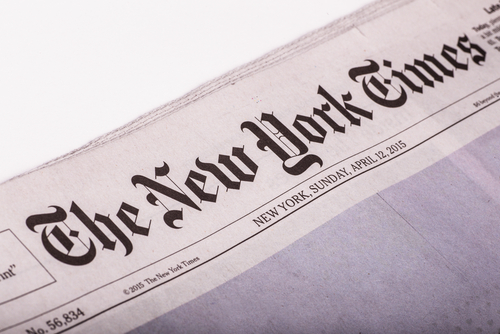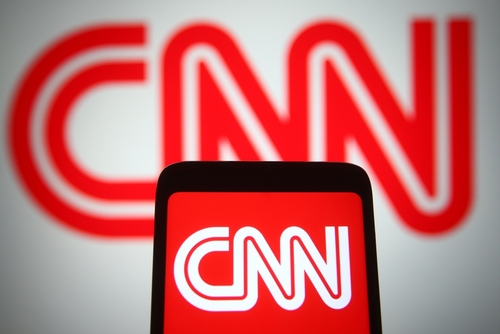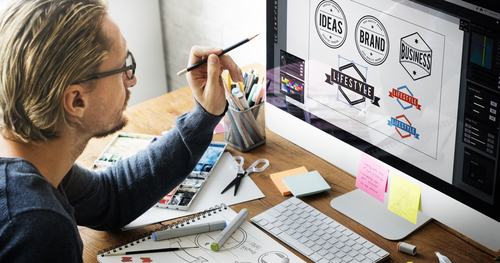Every business needs an impactful logo that can represent its brand identity. From a small mom-and-pop shop to a Fortune 500 company, having a logo that effectively communicates your mission, values, and goals can be the key to success. It’s a crucial aspect of differentiating you from the competition.
When figuring out exactly what type of logo you need, there are many factors you should consider. For instance, you must consider the right branding color palette and font style to convey your message.
Also, finding a creative designer to ensure the logo accurately reflects your company is vital.
Let’s explore why having a logo is essential for every business. We’ll outline its benefits and explain the design process, from deciding colors and fonts to testing it before making a decision.
Finally, we’ll share some key considerations for creating a logo that works for you and the resources available.
Let’s dive into this conversation on how to create a logo for your business to ensure that your business’s logo stands out from the competition!
Why you need a logo
Having a logo is essential for any business, as it serves as the face of your brand. A recognizable logo allows customers to recognize your company, product, or service.
You can create an identity that stands out from the competition. It will help people recognize and remember your company more quickly.
Logos are also important because they help establish customer recognition and trust. A professional logo helps lend credibility to your business. It shows potential customers that you are serious about what you do.
With the right design and implementation, you can use logos as powerful tools to build brand awareness and loyalty among customers. You can leverage logos on marketing materials such as brochures and websites. It creates a consistent look throughout all of your company’s promotional material.
A good logo should be eye-catching and memorable and communicate the values of your business in a few simple shapes or colors.
The design process can feel daunting at first. However, with careful consideration of font styles, color palettes, and graphic elements, you can create something truly unique that will make all the difference in establishing yourself in the market.
The benefits of having a brand identity
Having a strong brand identity is incredibly important for any business. It’s an excellent way to create a memorable presence in the marketplace.
Your brand identity gives your company and products an edge over the competition. It’s not just about having an attractive logo or website. It’s also about defining your company’s uniqueness and differentiating yourself from others.
By creating a strong brand identity, potential customers will be able to recognize who you are and what you offer. They won’t need any further explanation.
This can help build trust with them. They know precisely what they’re getting when they choose your brand, which increases their likelihood of returning for more.
Having a well-defined branding strategy will also give your employees something to rally behind. It provides clarity on how everyone should present themselves both internally and externally.
This kind of consistency within the organization helps foster a sense of team unity. It makes them feel proud about being part of something bigger than themselves.
It also allows for easy recognition among customers. People can instantly associate it with your business when looking at the brand’s ads or other promotions. This increases recognition even more!
By having a unified look, from logos to website design to print ads, customers will get a consistent impression of who you are as a business.
Additionally, establishing yourself through branding helps ensure that when potential customers see something related to your brand, they think, “Oh I know this place!” This familiarity helps create long-term relationships with clients, which can help drive sales in the future.
Having an impactful tagline or slogan can further reinforce your message. It also helps to connect with potential customers on an emotional level. All these aspects combined form a powerful toolkit for building a strong brand identity. An identity that will be instantly recognizable by everyone who comes into contact with it.
The logo design process
Creating a logo for your business is an essential step in establishing yourself as a professional. You can use your logo on everything from social media to website banners.
It serves as the central visual representation of your company. It’s essential to create something that reflects the values and mission of your business while also being eye-catching and memorable.
The best way to create a logo for your business is by researching what other companies in similar industries have done. This information gives you some ideas of what works well.
The first step in designing your logo is deciding on colors and fonts representing your company’s values. Once you nail those down, consider what graphic elements work best to bring your vision to life. This could be anything from abstract shapes or illustrations that communicate a message about what you do.
Then it would be best if you considered factors such as iconography and typography when designing yours.
Once you’ve created something that stands out from the crowd, ensure you get feedback from friends or family before finalizing it.
Choosing a branding color palette, logotype, and font style
When considering creating a logo for my small business, one of the most critical decisions is choosing a branding color palette.
Depending on what message you want to convey, picking the right colors can be critical in ensuring that your logo stands out from the competition.
Additionally, you should:
- Decide which type of logo would best represent your company– whether it’s an icon or text-based
- Find a font style that accurately communicates who you are and what makes you unique.
Finally, you can add creative graphic elements like abstract shapes or illustrations. They can help to bring all these pieces together into something memorable and impactful.
Ultimately, you will create a logo that perfectly reflects your business’s identity while differentiating you from competitors.
Now that you have an idea of your logo’s value, it’s time to decide the type of logo that will align with your business.
Wordmark
Wordmark logos have a freestanding design of the product name, company’s acronym, or name. This design visually conveys the brand’s attributes and uses typography but with a twist.
Some famous wordmark logos include Google’s colorful Product Sans typeface or The New York Times’ Old English type of BT font).

Source: Shutterstock
Brandmark
A brandmark boasts a visual design that instantly resonates with your brand in the customer’s mind. The creation achieves this effect by prompting an emotional reaction or connection with the viewer.
A great example of a brandmark logo is the Nike swoosh.
Combination Mark
A combination mark seamlessly merges the elements of a brandmark and a wordmark. For instance, the Starbucks logo combines the Starbucks mermaid, which is the brandmark, and the wordmark that encircles it.
Another great example is the Corvette logo.
Abstract Logo Mark
The abstract logo mark aims to portray the brand image using an icon or symbol. Adobe’s abstract rendition of the letter “A” is an excellent example of a recognizable and robust abstract logo.
Lettermark
A letter mark logo uses an abbreviated version of the business or product name for the design. In most cases, the logo consists of a minimalist design of the company’s initials.
Some mainstream examples of lettermark logos are Home Box Office (HBO) and Cable News Network (CNN).

Source: Shutterstock
Mascot Logo
Mascot logos are popular among sports teams because they make it easy for fans and customers to resonate with the brand.
Using your brand ambassador, you can also design a mascot logo for your business. KFC’s Colonel Sanders and Pillsbury’s Doughboy are prominent businesses with mascot logos.
Emblems
Emblem logos merge the business name and some icons or symbols to reflect the brand. Such logos are famous in government institutions such as schools, but you can also adopt one for your business.
Symbols
If you prefer using a symbol, you can brainstorm some ideas using these tips:
- Establish Connections
You can start by thinking about words related to your business or company name. For instance, if your name has to do with growth, think along the lines of leaves, trees, branches, and related images.
- Be Figurative
During this discovery stage, consider the message you’d like to pass to your audience or what you’d like them to feel. Note down the symbols that come to mind.
- Think Literally
Although most designers advise against using obvious choices, exploring literal interpretations of your message is a great idea. You can play around with a few examples and add unique aspects. For instance, you can combine something figurative with a literal symbol.
Fonts
If you prefer a lettermark or wordmark logo, an essential aspect to consider is typography. Like colors, fonts can also prompt different explanations of your brand personality.
There are numerous font types that fall into three categories or typefaces, namely: script, sans serifs, and serifs.
- Serif Fonts
Serif fonts are classic and excellent if your goal is to communicate sophistication, tradition, and trust.
- Sans Serif Fonts
These fonts are crisp and have a modern, sleek look, so they are perfect if you’re going for a minimalist design.
- Script
Script fonts have a more original and authentic feel because they create a signature effect in cursive handwriting.
Finding a creative designer
If you’re wondering how to create a logo for your business brand, finding a creative designer will help bring your vision to life. It can be daunting, but the right person for the job will make all the difference.
Creative designers often have years of experience crafting logos. They create logos that communicate effectively while still being aesthetically pleasing.
They know how to create a logo for my small business that resonates with customers on an emotional level while representing everything about your brand.
Start by researching designers in your area who have experience with logos and branding projects — look at their portfolios and read reviews from other clients.
Once you’ve narrowed down your choices, reach out for an initial consultation. It will give you a sense of how they work and if their style is something that aligns with what you are looking for. Ask questions about timelines, budgets, and any other specific needs or preferences you may have before deciding on whom to hire.
You should be able to find someone who understands precisely what it takes to create something unique that accurately reflects who you are and conveys your message in an impactful way.
Testing the logo
Testing your logo is an essential step in the branding process. It helps you ensure that your design will be recognizable and effective on any medium.
One of the first things to consider when testing a logo is its appearance on different backgrounds, sizes, and color schemes. It can help you decide if you need to adjust certain elements or if you should add or remove anything.
Additionally, it would help if you considered how the logo would look with other items, such as business cards or letterheads. It can give you insight into whether it’s legible enough for all materials.
Finally, take time to review feedback from friends and family who have seen the design. Their opinions may provide valuable input that could influence changes before making a final decision.
With careful consideration throughout the design process, you will end up with something memorable that accurately represents who you are and what makes your business unique. With an awesome-looking brand identity behind you – success will surely follow!
How to create a logo that works for you – Key considerations
The benefits of creating an effective brand identity can be immense. It sets you apart from competitors and creates an emotional connection between potential customers and your company, which can significantly increase sales over time.
With a strong image in place, customers will form positive associations with your product/service, which makes them much more likely to become repeat buyers.
Additionally, having clear messaging around why someone should choose your business ensures that everyone knows exactly what makes you unique – leading to higher customer satisfaction rates and increased loyalty over time.
The first step when outlining the steps on how to create logo is considering the key characteristics that will make it stand out from the crowd.
Think about the overall message you want it to convey, what emotions it should evoke, and how it will fit with your existing branding materials.
Keep in mind that your logo will be visible on various platforms – make sure it looks as good on a business card as it does on an internet banner or billboard.
Additionally, it should be easily identifiable and easy to remember. Ensure that you create a logo that works for you and reinforces your brand’s message on all types of media.
Start by creating ideas that best represent who you are and what makes your business unique. Consider colors, fonts, shapes, or illustrations that communicate this message before thinking about how the logo will look on different backgrounds and sizes and other items like letterheads or business cards.
Once all these pieces fall into place, test the design to ensure it works in various scenarios before making a final decision.
Resources
Creating a professional logo is integral to branding your business and can be the difference between customers recognizing you or not.
It’s essential to take the time to come up with ideas that accurately represent what your brand stands for and make sure that it’s visually appealing as well.
Brainstorming different concepts, researching other logos in your industry, and using online tools are great ways to get started. For instance, you can use mockup generators to create a logo that will stand out from the competition.
For those on a tight budget, plenty of free tools offer basic design capabilities, such as Canva and Adobe Spark. These services allow you to create something simple yet effective by providing templates, color palettes, and fonts at no cost.
Suppose you’re looking for more control over the end result or need access to higher-quality designs. In that case, there are also paid options like 99 Designs which provide access to professional designers who can help bring your vision to life.
With so many different services out there, it will take research and testing before finding something perfect.
Test out different platforms until one clicks with what you had envisioned. It may take time, but ultimately having access to these kinds of high-quality services will pay off when crafting something unique that stands apart from competitors.
A logo can benefit your business and play a vital role in establishing a solid brand identity. It provides customers with recognition and recognition. Furthermore, learning how to create a logo and making your logo memorable with unique creativity can help build consumer loyalty for years to come.

